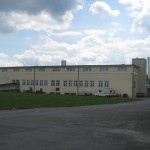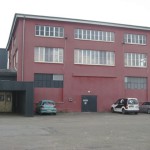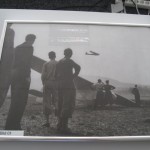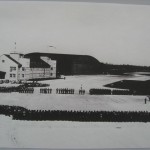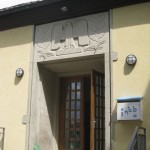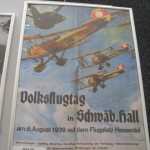 Now talk about old Second World War Airfields in the the UK and you’ll find none more informed than our Trevor. He has visited and researched more airfields from the period than anyone knew there were so last time we went out to Germany I took a leaf out of his book and once more asked Mien Host Karle another delicate question. “Karle, are there any remains of Schwabisch Halle when it was known as Hessental, famous for being an Me262 base?” It is quite widely acknowledged that had Hitler allowed the production and implementation of the highly advanced twin-engined jet as a fighter rather than a bomber then the effect on the Allied bombers would have been devastating. Apart from being an assembly facility Schwabisch Halle was also home to a number of operational groups including KG51 and later the successful photo-reconnaissance 262s of NAG6. Once again John winced. I’d asked a similar question some years ago of the airports’ manager as he drove me across to the Control Tower. “Are there any WW2 hangars left?”. “Just the one.”
Now talk about old Second World War Airfields in the the UK and you’ll find none more informed than our Trevor. He has visited and researched more airfields from the period than anyone knew there were so last time we went out to Germany I took a leaf out of his book and once more asked Mien Host Karle another delicate question. “Karle, are there any remains of Schwabisch Halle when it was known as Hessental, famous for being an Me262 base?” It is quite widely acknowledged that had Hitler allowed the production and implementation of the highly advanced twin-engined jet as a fighter rather than a bomber then the effect on the Allied bombers would have been devastating. Apart from being an assembly facility Schwabisch Halle was also home to a number of operational groups including KG51 and later the successful photo-reconnaissance 262s of NAG6. Once again John winced. I’d asked a similar question some years ago of the airports’ manager as he drove me across to the Control Tower. “Are there any WW2 hangars left?”. “Just the one.” 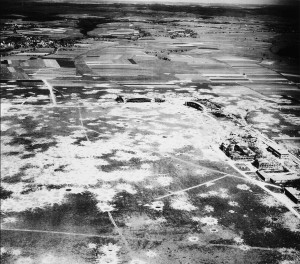 Came the reply, accompanied by a wry smile, ”You bombed all the others,” which is where it all sort of ended that time out apart from the moment we walked into the Terminal Building where the door was being kept open by a large bomb in a cradle. “One of ours?” I loudly asked John, who had to leave the building before he corpsed. As Karle had kindly taken us on a tour of the Zeppelin Field when asked I reckoned he may have been half expecting the question. “Oh yes indeed, I’ll show you.” John opted not to get involved with rusty stuff and ended up touring a monastery but that’s another story.
Came the reply, accompanied by a wry smile, ”You bombed all the others,” which is where it all sort of ended that time out apart from the moment we walked into the Terminal Building where the door was being kept open by a large bomb in a cradle. “One of ours?” I loudly asked John, who had to leave the building before he corpsed. As Karle had kindly taken us on a tour of the Zeppelin Field when asked I reckoned he may have been half expecting the question. “Oh yes indeed, I’ll show you.” John opted not to get involved with rusty stuff and ended up touring a monastery but that’s another story.
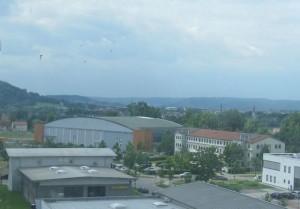 Now known as Schwabisch Hall the airfield is somewhat different today. Home to the immaculately kept Adolf Wurth Airport it has a fine new concrete runway re-aligned to miss the beautiful medieval town a mile or so away. The ‘new airport’ is separated from both the old hangar and buildings along with the control tower by a modern road, which does seem a bit odd but actually works very well. Its rumoured that the remains of over 1000 bits of ordnance, some un-exploded, were removed before work could start. Apart from a bevy of very executive jets it welcomes all aviation and has a very active gliding club which is were it all started. Regular visitors include members of our royal Family who have been seen passing through! The origins of the airfield have become somewhat muddled by political correctness but essentially it started out as local venture to create a gliding club and work on the airfield proper started in 1933. This was right at the time that the Luftwaffe was created and the vast majority of flying and gliding clubs came under the control of the Nazis. Officially,
Now known as Schwabisch Hall the airfield is somewhat different today. Home to the immaculately kept Adolf Wurth Airport it has a fine new concrete runway re-aligned to miss the beautiful medieval town a mile or so away. The ‘new airport’ is separated from both the old hangar and buildings along with the control tower by a modern road, which does seem a bit odd but actually works very well. Its rumoured that the remains of over 1000 bits of ordnance, some un-exploded, were removed before work could start. Apart from a bevy of very executive jets it welcomes all aviation and has a very active gliding club which is were it all started. Regular visitors include members of our royal Family who have been seen passing through! The origins of the airfield have become somewhat muddled by political correctness but essentially it started out as local venture to create a gliding club and work on the airfield proper started in 1933. This was right at the time that the Luftwaffe was created and the vast majority of flying and gliding clubs came under the control of the Nazis. Officially,  in 1935 the Third Reich took over what had become Hessental Flugplatz and it was designated an airbase or rather ‘Fliegerhorst’. By the outbreak of war it was home to Me109s and Ju52s and was soon accommodating Heinkel 1-11 and Me110 night fighters and later the Ju88 and He177 Griefs equipped with the early radio controlled bombs, pre-cursors of the modern cruise missile but it was the arrival of the Me262 that finally put it on the map as a target for the low level fighter bomber and later heavy bomber attacks.
in 1935 the Third Reich took over what had become Hessental Flugplatz and it was designated an airbase or rather ‘Fliegerhorst’. By the outbreak of war it was home to Me109s and Ju52s and was soon accommodating Heinkel 1-11 and Me110 night fighters and later the Ju88 and He177 Griefs equipped with the early radio controlled bombs, pre-cursors of the modern cruise missile but it was the arrival of the Me262 that finally put it on the map as a target for the low level fighter bomber and later heavy bomber attacks.
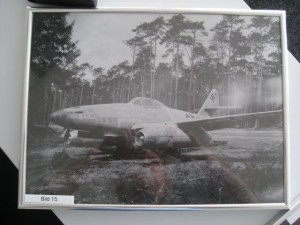 The history of the Me262 is well-documented but basically by the time it entered service much of the manufacturing was carried out at well-hidden locations the components being delivered and assembled at various airfields meaning that the finished aircraft were test flown well away from the manufacturing facilities. So it was that with its railway links and a somewhat remote location, Hessental became such a centre. Above the airfield hidden in the woods was the Hasenbuhl Assembly Plant now a shooting range. Here the aircraft were assembled and towed down to the airfield for test flying, painting and delivery to operational units. The location was well chosen. Of the four extremely heavy bombing raids carried out by the US Army Air Corps in 1944 and 1945, although the infrastructure
The history of the Me262 is well-documented but basically by the time it entered service much of the manufacturing was carried out at well-hidden locations the components being delivered and assembled at various airfields meaning that the finished aircraft were test flown well away from the manufacturing facilities. So it was that with its railway links and a somewhat remote location, Hessental became such a centre. Above the airfield hidden in the woods was the Hasenbuhl Assembly Plant now a shooting range. Here the aircraft were assembled and towed down to the airfield for test flying, painting and delivery to operational units. The location was well chosen. Of the four extremely heavy bombing raids carried out by the US Army Air Corps in 1944 and 1945, although the infrastructure 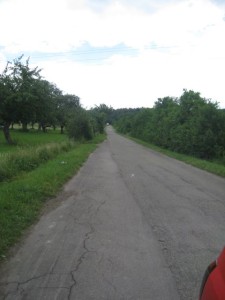 of the airfield was badly damaged, the site of Me262 assembly plant went unscathed. It was natural then to start our tour by driving up the road and into the woods where the tarmac gave way to what were clearly old concrete roads and dispersal points. Unfortunately the ranges were closed but parts of it still stand today behind an imposing security fence! Clearly visible from the road is also the now disused spur line off the main railway line that served the base bringing in both parts and fuel.
of the airfield was badly damaged, the site of Me262 assembly plant went unscathed. It was natural then to start our tour by driving up the road and into the woods where the tarmac gave way to what were clearly old concrete roads and dispersal points. Unfortunately the ranges were closed but parts of it still stand today behind an imposing security fence! Clearly visible from the road is also the now disused spur line off the main railway line that served the base bringing in both parts and fuel.
 We drove back into the site of the old base and Hessental and it was soon became very evident how many barracks and houses of the period actually remain, all clearly identifiable by their Romano-concrete design with many still retaining their decorative doorways and now used as private houses or offices. A rather picturesque but grand villa, the Commandants old house, is now a nursery school. Of the old airfield the original control building is still pretty much as it was along with the impressive old central stores building. Beside one of the other administrative blocks, a vehicle compound under US hands, is a rather scary concrete pillbox. Quite how effective it would have been is anyone’s guess.
We drove back into the site of the old base and Hessental and it was soon became very evident how many barracks and houses of the period actually remain, all clearly identifiable by their Romano-concrete design with many still retaining their decorative doorways and now used as private houses or offices. A rather picturesque but grand villa, the Commandants old house, is now a nursery school. Of the old airfield the original control building is still pretty much as it was along with the impressive old central stores building. Beside one of the other administrative blocks, a vehicle compound under US hands, is a rather scary concrete pillbox. Quite how effective it would have been is anyone’s guess. 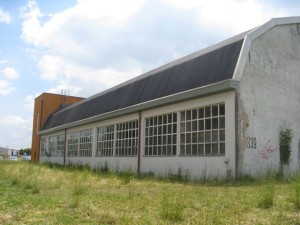 What is impressive is the remaining hangar. Most notable is the extent of glass allowing plenty of light in. This was where the finished Me262s were painted prior to delivery. It is a monster of a building. This along with the control building somehow escaped the heavy bombing and is just as it was apart from the loss of the original hangar doors.
What is impressive is the remaining hangar. Most notable is the extent of glass allowing plenty of light in. This was where the finished Me262s were painted prior to delivery. It is a monster of a building. This along with the control building somehow escaped the heavy bombing and is just as it was apart from the loss of the original hangar doors. 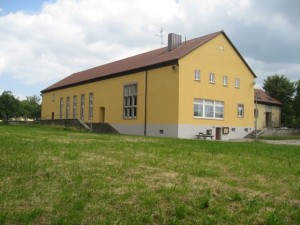 Across from this amongst trees and what were once terraced lawns is the Officers Mess. It is a warm friendly looking building, a sort of across between a Roman Villa and barn conversion with a magnificent window and heavily adorned entrance door.
Across from this amongst trees and what were once terraced lawns is the Officers Mess. It is a warm friendly looking building, a sort of across between a Roman Villa and barn conversion with a magnificent window and heavily adorned entrance door.
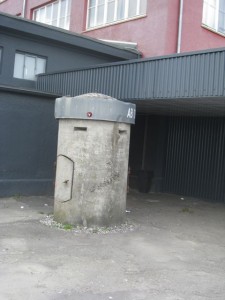 There are a few smaller blockhouses dotted about and a semblance of the original layout but when it became a US base after end of WW2 much of the site lay in ruins and had to be demolished. It is now being re-developed as an industrial area with new roads and modern hi-tech buildings. Looking back across from the new control tower the remaining hangar and original Control Building are still imposing and you can still make out the sweep of the original layout. The Control Building is now an office block and in immaculate condition fronted by trees and flower beds, a far cry from freshly painted Me262s taxiing out or the backdrop to parades.
There are a few smaller blockhouses dotted about and a semblance of the original layout but when it became a US base after end of WW2 much of the site lay in ruins and had to be demolished. It is now being re-developed as an industrial area with new roads and modern hi-tech buildings. Looking back across from the new control tower the remaining hangar and original Control Building are still imposing and you can still make out the sweep of the original layout. The Control Building is now an office block and in immaculate condition fronted by trees and flower beds, a far cry from freshly painted Me262s taxiing out or the backdrop to parades. 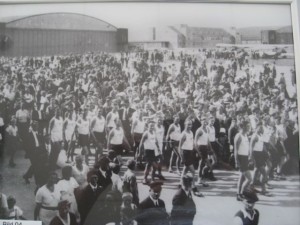 Like all abandoned airfields I’m sure if you poke about long enough you will find the remains of damaged aircraft or corroding parts but being Germany I expect most, if not all, has been cleared up. Are the VIPs that touch down in their Citations aware of the past history of this largely forgotten place? Probably not. Is it important that it is remembered? Probably. The medieval town of Schwaebisch Halle itself mainly escaped the bombings of the larger towns and cities but the airfield was heavily targeted once its importance was realised.
Like all abandoned airfields I’m sure if you poke about long enough you will find the remains of damaged aircraft or corroding parts but being Germany I expect most, if not all, has been cleared up. Are the VIPs that touch down in their Citations aware of the past history of this largely forgotten place? Probably not. Is it important that it is remembered? Probably. The medieval town of Schwaebisch Halle itself mainly escaped the bombings of the larger towns and cities but the airfield was heavily targeted once its importance was realised. 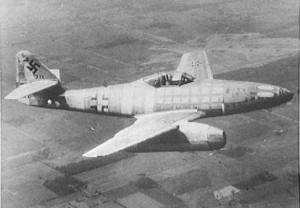 It would be wrong as well not to mention the Concentration Camp set up near the station that provided labour to repair and maintain the base especially after bombing raids. It is also the base from which Hans Fay, Messerschmitt’s famous test pilot, flew the first Me262 to Rhein/Maine aerodrome and handed it over to the American Forces on 30 March 1945. This remarkable feat followed the abandonment of Hessental ahead of the approaching American Forces and the need to remove all airworthy aircraft to Neuberg.
It would be wrong as well not to mention the Concentration Camp set up near the station that provided labour to repair and maintain the base especially after bombing raids. It is also the base from which Hans Fay, Messerschmitt’s famous test pilot, flew the first Me262 to Rhein/Maine aerodrome and handed it over to the American Forces on 30 March 1945. This remarkable feat followed the abandonment of Hessental ahead of the approaching American Forces and the need to remove all airworthy aircraft to Neuberg.
 Back in the main airport buildings we adjourned to the store room where we were told many pictures were stored. Indeed they were. Pictures of the original buildings and the fire crew, one of which was a relation to Karle. There were also some pictures of refuelling and rearming the aircraft but sadly none of the He177, feared more by its pilots than the enemy on account of the linked engines catching fire and appropriately nick-named ‘the flaming coffin’.
Back in the main airport buildings we adjourned to the store room where we were told many pictures were stored. Indeed they were. Pictures of the original buildings and the fire crew, one of which was a relation to Karle. There were also some pictures of refuelling and rearming the aircraft but sadly none of the He177, feared more by its pilots than the enemy on account of the linked engines catching fire and appropriately nick-named ‘the flaming coffin’.  Hanging on the corridor wall was a fantastic aerial picture of a bombing raid taken in 1945 along with a series of ‘Top Secret’ American notices about the base and missions against it. The final raid saw 82 Liberators drop 3700 bombs and ordnance across the airfield. Our bomb in the foyer was probably one of them. Just the thing for morale and calming the passengers we joked! When the Americans did arrive they found many part finished and part destroyed Me262s up in the woods, testament to the problems of parts delivery and maintenance of these complicated aircraft and the lack of pilots capable of flying them. Most of the bits and airframes were shipped back to the States. Hans Fay’s aircraft was extensively tested at the Wright Field in Ohio. It was destroyed in August 1946 following a fire in both engines but the pilot, McAuley, survived despite hitting the tailplane whilst baling out. These days the records of the bombing raids carried out against the airfield are online along with some remarkable photographs. Most interesting are the ones showing the tell-tale streaks on the runway from the jet engines. There is a museum dedicated to the period but we have yet to visit that.
Hanging on the corridor wall was a fantastic aerial picture of a bombing raid taken in 1945 along with a series of ‘Top Secret’ American notices about the base and missions against it. The final raid saw 82 Liberators drop 3700 bombs and ordnance across the airfield. Our bomb in the foyer was probably one of them. Just the thing for morale and calming the passengers we joked! When the Americans did arrive they found many part finished and part destroyed Me262s up in the woods, testament to the problems of parts delivery and maintenance of these complicated aircraft and the lack of pilots capable of flying them. Most of the bits and airframes were shipped back to the States. Hans Fay’s aircraft was extensively tested at the Wright Field in Ohio. It was destroyed in August 1946 following a fire in both engines but the pilot, McAuley, survived despite hitting the tailplane whilst baling out. These days the records of the bombing raids carried out against the airfield are online along with some remarkable photographs. Most interesting are the ones showing the tell-tale streaks on the runway from the jet engines. There is a museum dedicated to the period but we have yet to visit that.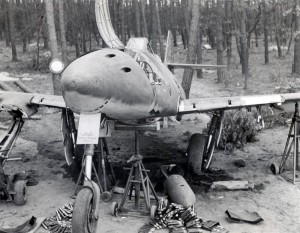 Next time maybe. I think perhaps the most strangely strange bit of the place is the woods. It still has an air of secrecy about it and it isn’t difficult to imagine it as it was. Today though it is a very quite peaceful place until a Lear Jet climbed steeply away from the new airport heading for Zurich. We wondered if the pilot knew how much his steed owed to the Me262? What many do not realise is that the gas turbines required overhaul every ten hours and they were flying a very little understood engine on the edge of known science running on fuel produced from coal in a time of extreme shortages. Think about it next time you are on your way to Barcelona aboard a 737. We have come a very long way. They were very courageous and brave men those Swallow pilots. We owe them a lot.
Next time maybe. I think perhaps the most strangely strange bit of the place is the woods. It still has an air of secrecy about it and it isn’t difficult to imagine it as it was. Today though it is a very quite peaceful place until a Lear Jet climbed steeply away from the new airport heading for Zurich. We wondered if the pilot knew how much his steed owed to the Me262? What many do not realise is that the gas turbines required overhaul every ten hours and they were flying a very little understood engine on the edge of known science running on fuel produced from coal in a time of extreme shortages. Think about it next time you are on your way to Barcelona aboard a 737. We have come a very long way. They were very courageous and brave men those Swallow pilots. We owe them a lot.
http://zenoswarbirdvideos.com/Images/Me262/ME262PILOTDEBRIEF.pdf Hans fay’s debrief after taking the Me262 from Schwabisch Halle. Quite amazing.
http://www.b24.net/missions/MM091344.htm Mission report against Schwabisch Halle 13.09.44
Update 12 May 2022 – We were contacted by Michael Koziol explaining that the pictures we had taken of the pictures held in the Control Tower were in fact given to the airport by him and they form part of a large collection of material that he has gathered. We had no idea that they were not the property of the airport and apologise fully. Please note that all the black and white pictures along with the middle picture second row up from the bottom form part of his research. We have since been back a couple of times and had the opportunity to visit the museum which is opened by arrangement.I have also been presented by with a fantastic book by my good friend Karle Grunauer, one of the air traffic controllers, written by Michael Koziol called Fliegerhorst (Home Base) which is a history of the airfield from 1934-1987 and is in both German and English. He has very kindly permitted us to continue to post them but they are copyright.
Good read is ‘Me262 Bomber and Reconnaissance Units’ by Robert Forsyth published by Osprey.

